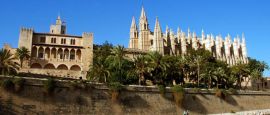Palma’s dazzling museum of modern and contemporary art and sculpture contains works by world-renowned artists as Cézanne, Matisse, Dalí and Picasso, together with a remarkable collection of Balearic paintings too. The sprawling museum has permanent displays and temporary exhibitions.
Things to see in Palma de Mallorca
Tourist offices
Address: Plaça de la Reina 2, Palma, 07012, Spain
Tel: +34 971 17 39 90.
Opening Hours:Mon-Fri 0830-2000, Sat 0830-1500. www.infomallorca.net
This centrally located information centre offers guidance, bookings, brochures and maps. There is another tourist information office at the airport (tel: +34 971 789 566), which is open Mon-Sat 0830-2000 and Sun 0900-1330, and one at the Port de Palma (tel +34 971 707 400), open Mon-Fri 0830-1600.
Dominating the waterfront, Palma’s majestic sandstone cathedral is one of the largest and most beautiful gothic cathedrals in the world. With a striking exterior, the landmark is the most important building in Palma, and a must-see when on the island. La Seu enjoys a remarkable location on top of the old citadel.
Rising out of the city’s defensive walls on the seafront, the Royal Palace of La Almudaina was originally constructed as a Muslim alcazar during the Arab Conquest in AD 902. With its remarkable blend of gothic and Moorish architecture, it is beautiful both on the inside and outside – especially the royal chapel and gothic hall.
The city’s extensive seafront illustrates Mallorca’s long-standing love affair with the sea, with everything from tiny traditional fishing boats to super-yachts, naval vessels and massive cruise liners. At the eastern end are La Llotja (Maritime Exchange) and the Consulat del Mar (Sea Tribunal) – grand historic buildings reminiscent of Palma’s Renaissance maritime achievements.
Built in the 13th century, the Basilica of St Francis was remodelled in the 17th century with a typically Mallorquin exterior – but this dull facade belies an exuberant baroque interior. The real draw is the church’s cloister, which is a veritable oasis of peace at the heart of the old town.
Spain’s only circular castle is so well preserved that it is hard to believe it was constructed over 700 years ago as a royal palace. Today, you can visit the local history museum within the castle and admire a truly bell ver (beautiful view) of Palma Bay from its rooftop.
As one of the best modern art museums in the Balearics, Museu Fundación Juan March has a permanent collection of 70 works by some of Spain’s most important contemporary artists such as Pablo Picasso, Joan Miró, Juan Gris and Salvador Dalí. The eclectic museum is housed in a 17th-century mansion known as the Can Gallard des Canyar.
In the city centre, these adjoining squares are home to some of the island’s most remarkable modernista (Spanish art nouveau) architecture. Highlights include the ornamental Gran Hotel (today the Fundació La Caixa art gallery), the Forn des Teatre bakery and, in Plaça Mercat, Pensió Menorquina and Can Casasayas.
The only remaining Moorish building in Palma, these ancient baths are thought to date back to the 10th century. Each of the columns that line the central courtyard is different because it is likely that they were recycled from the ruins of Roman buildings.
Built in the 13th century, this imposing building is the city’s guildhall, and also one of the most striking buildings in Palma. As part of the maritime sea wall, the building was originally the headquarters of the School of Merchants. The Llotja has gothic architectural details on both the exterior and interior, including intricately carved sculptures, arches and ornamentation.
Do you have any Feedback about this page?
© 2025 Columbus Travel Media Ltd. All rights reserved. No part of this site may be reproduced without our written permission, click here for information on Columbus Content Solutions.








 You know where
You know where